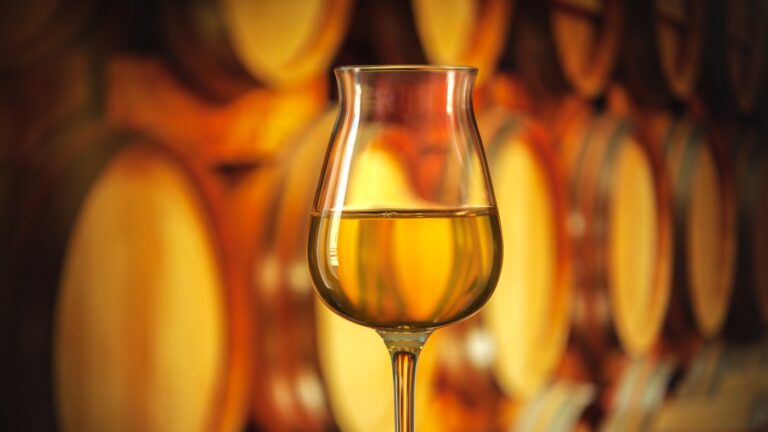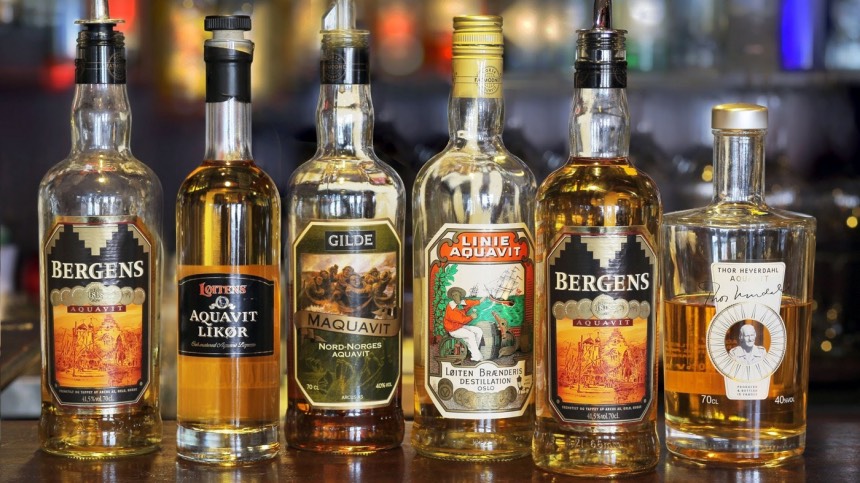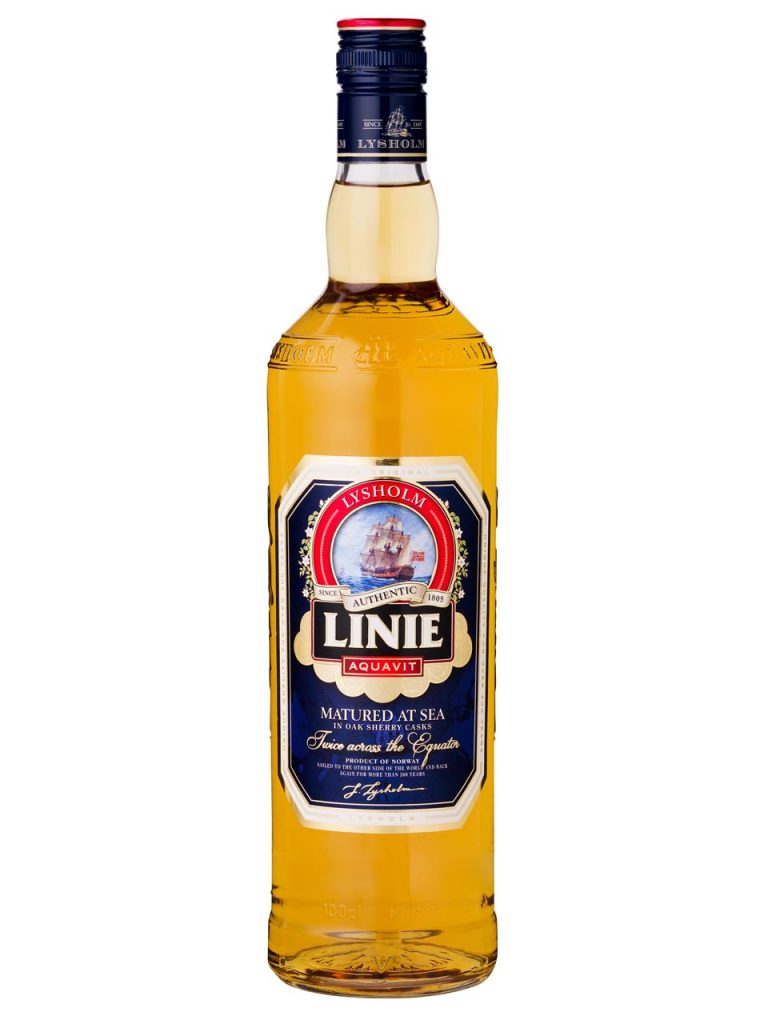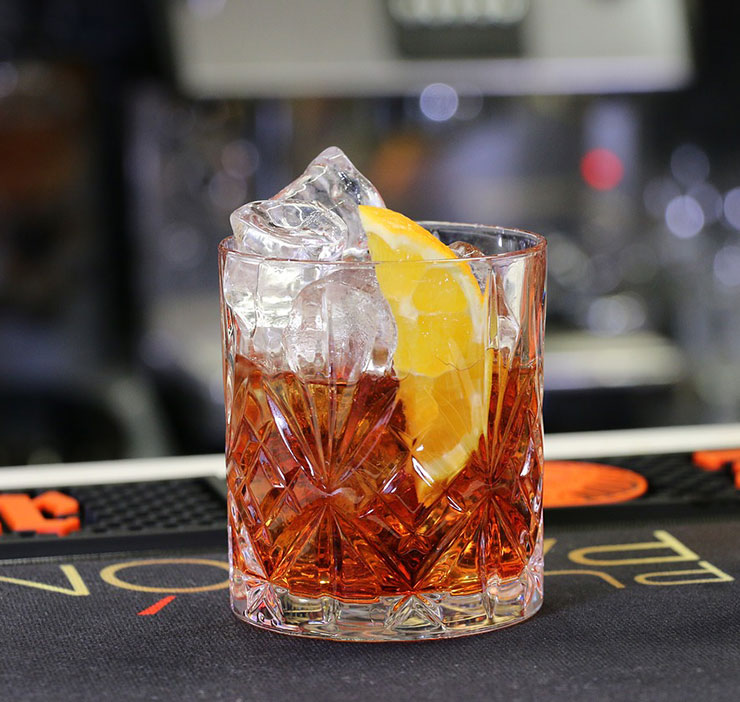Long favoured by older Scandinavians, Norwegian aquavit is finding new fans among foodies and cocktail lovers around the world.
Once a staple of Nordic holiday tables, aquavit is now riding the wave of New Nordic cuisine to gain attention far beyond Scandinavia. The name comes from the Latin aqua vitae, meaning “water of life,” and reflects its origins as a medicinal tonic.

Aquavit has been produced in the Nordic region since at least the 15th century, and it still plays an important role in many cultural traditions. In Norway, it’s often sipped slowly during festive meals, paired with cured meats or fish, and toasted with a firm “Skål!”
While recipes and traditions vary across Scandinavia, all true aquavit must derive its dominant flavour from caraway or dill, according to European Union rules.
These earthy, herbal notes, often supported by botanicals such as fennel, citrus peel or anise, give aquavit a distinctive character that sets it apart from clear spirits like vodka or gin.
Whether aged in oak or served ice-cold in a shot glass, aquavit is both a cultural symbol and a surprisingly versatile drink worth discovering.
How Do You Spell Aquavit?
Let’s clear up the question of spelling right from the start. You might see the word spelled in several different ways: aquavit, akvavit, or akevitt. All are correct. They’re simply variations used in different languages and regions.
Aquavit is the international and English-language spelling, derived from the original Latin aqua vitae (“water of life”). Akvavit is the standard form in Danish and Swedish, while akevitt is the Norwegian version.

Spelling differences like this are common across Scandinavia, and even within Norway itself. With two official written forms and a wide range of regional dialects, you’ll quickly get used to seeing multiple versions of the same word.
What Does Aquavit Taste Like?
At first glance, aquavit might remind you of gin. After all, they’re both spirits flavoured with botanicals. But while gin relies on juniper berries, aquavit must be flavoured primarily with either caraway or dill. This gives it a markedly different profile: less piney, more earthy and herbal.
The best word to describe the flavour of aquavit is savoury. Depending on the brand and how it’s made, it can range from sharp and bracing to smooth and rounded. Aged aquavit tends to have a softer, richer taste with hints of vanilla, spice and oak, while unaged versions are often cleaner and more assertive.
Aquavit is a strong spirit, typically bottled at 40% ABV. Under European regulations, it must be at least 37.5% to qualify as aquavit.
Compared to gin, aquavit often has a more immediate and recognisable flavour, especially because its dominant spices caraway or dill tend to shine through even when mixed into cocktails.
How Is Aquavit Made?
Like vodka and gin, aquavit begins as a neutral spirit, typically distilled from either grain or potatoes. The choice of base ingredient often reflects regional traditions.
In Norway, aquavit is most commonly made from potatoes, which ties in with the country’s long agricultural history. In contrast, Swedish and Danish producers tend to use grain, resulting in a slightly lighter texture and cleaner taste.
After distillation, the spirit is flavoured with a blend of herbs and spices, known as botanicals. While recipes vary by producer, European regulations state that the dominant flavour must come from either caraway or dill. These herbs give aquavit its distinctive savoury and slightly medicinal character.
Other commonly used botanicals include cardamom, cumin, fennel, anise, coriander, and citrus peel. Each adds its own layer of complexity, giving different brands their own unique identity. Some aquavits emphasise warming spice, others lean towards fresh herbs or a hint of citrus.

At this point, the aquavit may be bottled immediately. These unaged versions are typically clear and colourless, a style more common in Denmark and Sweden. Served chilled, they tend to have a clean and bracing flavour.
Norwegian aquavit, however, is usually aged in oak barrels. This process gives the spirit a golden or amber colour and helps round out the flavours, adding notes of vanilla, wood, and spice.
Some producers also use caramel colouring to adjust the appearance or maintain consistency between batches, particularly in younger aquavits.
The final colour can offer a clue about the taste. Pale aquavits are often sharper and more peppery, while darker varieties tend to be smoother, richer, and more complex, especially those aged in smaller or newer barrels.
Norwegian Aquavit
Norwegian aquavit stands apart from its Danish and Swedish counterparts in both colour and complexity.
While many Scandinavian brands are clear or pale in colour, most Norwegian aquavits are matured in oak casks, which gives them a distinctive golden hue and a smoother, fuller flavour.
This ageing process typically lasts at least a year, though some aquavits are aged for much longer—up to twelve years in some cases. Maturation in oak introduces subtle notes of vanilla, spice, and wood, deepening both the colour and character of the spirit.
Ask a Norwegian, and they’ll tell you their aquavit has the boldest flavour and most distinctive personality. Whether that’s a good thing or not is, of course, up to the drinker.
The most famous example is Linie Aquavit, which follows a unique ageing tradition. Since the early 1800s, barrels of Linie have been loaded onto ships and sent from Norway to Australia and back, crossing the equator—the linje—twice along the way.
The constant motion, fluctuating temperatures, and varying humidity are believed to accelerate the ageing process and enhance the flavour.

The practice began in 1805, when a Norwegian trading family, Lysholm, shipped aquavit to the East Indies.
When the shipment failed to sell, it was returned to Norway, only for the family to discover that the spirit had dramatically improved during the sea voyage. Ever since, every barrel of Linie has taken the same journey before bottling.
Today, that same tradition continues. Ships packed with Linie barrels still set sail from Norway, and the finished product is sold not only at home but around the world.
Naturally, this labour-intensive process makes Linie one of the more expensive aquavits on the market, but for many, it's worth the extra cost.
How to Serve and Drink Aquavit
Aquavit remains an important part of Scandinavian drinking culture, though it’s typically reserved for special occasions rather than everyday use. In Norway, it’s most associated with Christmas dinners, Easter meals, weddings, birthdays and Constitution Day celebrations.
It’s also enjoyed as an aperitif, particularly in the wider Nordic and German-speaking regions.
In Sweden, Denmark, and Germany, aquavit is often served ice-cold in a small shot glass, designed to be downed in one go. In Finland and Sweden, it’s a firm fixture at traditional crayfish parties, where it’s accompanied by singing and laughter.
Things are a little different in Norway. Here, aquavit is usually served at room temperature in a tulip-shaped glass that concentrates the aromas. That makes it ideal for sipping slowly and appreciating the complexity of the spirit. These glasses make a nice souvenir for any spirits enthusiast.
Serious aquavit drinkers will savour the aged character and subtle layers of cumin, citrus peel and oak. Less serious drinkers might recommend something else entirely: a shot of aquavit followed by a gulp of dark beer. It’s a combination that many Norwegians swear by, though I’ve yet to be convinced.
A friend of mine insists the way to drink aquavit is with a plate of fatty food to hand. As you can see, there's many different ways, so experiment yourself and find your favourite!
No matter how you take it, one thing is essential: raise your glass, meet the eyes of your drinking companions, and say a firm Skål!
Experiment with Aquavit Cocktails
Neat aquavit might be an acquired taste for many outside Scandinavia, but it turns out the spirit works remarkably well in cocktails, especially those that call for gin or vodka. The herbal, savoury notes bring an extra layer of complexity that can make familiar recipes feel entirely new.
In Norway, the aptly named Friends of Aquavit (yes, it’s a real organisation) promoteseveral cocktail ideas on their website, using Linie and other aged aquavits as the base.

While traditionalists may raise an eyebrow at the thought of mixing their beloved spirit, experimenting is all part of the fun—and a good way to introduce aquavit to new drinkers.
You can use aquavit in place of gin or vodka in many classic cocktails. Just be aware that its bold flavours—caraway, citrus, fennel, oak—will change the character of the drink, sometimes dramatically. That can be a good thing.
Before dinner: If you enjoy strong, bitter aperitifs, try swapping out the gin in a Negroni for aged aquavit. The result is an even more intense and aromatic version of the classic Italian cocktail, ideal for whetting the appetite.
After dinner: For something to help you wind down, consider an aquavit twist on the espresso martini. Replacing part (or all) of the vodka with aquavit gives the drink a subtly spiced depth, not unlike Turkish coffee with cardamom.
There’s plenty of room to experiment, whether you’re making a Nordic Bloody Mary or just adding a dash of aquavit to a G&T. The only rule is to enjoy it.
Where to Try or Buy Aquavit in Norway
Aquavit is sold at Vinmonopolet, Norway’s state-run liquor store chain. Look for local favourites such as Linie, Gilde, Løiten, and Opland.
Many traditional restaurants serve it alongside festive meals, especially at Christmas. And if you're visiting during the holiday season, keep an eye out for limited-edition bottles that often appear on shelves.
Beyond a festive drink, aquavit is a symbol of Scandinavian heritage, with roots in farming, feasting, and folklore. One of the best ways to get acquainted with Norway’s iconic spirit is by following the country’s newly developed Aquavit Trail.
This scenic route winds through the rolling landscapes of Trøndelag, in central Norway, and links together historic distilleries, charming farmhouses, boutique hotels, and local eateries.
Along the way, visitors can sample different styles of aquavit and learn about the distilling traditions that shaped the region. Many stops on the trail also offer locally sourced meals, with Trøndelag’s acclaimed food scene providing the perfect pairing.
Whether you’re a spirits enthusiast or simply curious, there are few better ways to explore Norway’s culinary heritage than by sipping your way through its heartland. Whether you go for a classic Linie or a bold local variety, be sure to raise your glass with a hearty Skål!


I like your article on Aquavit, and you hit it right when you singled out Linie Aquavit as the favorite one. I am surprised, though, that you omitted to mention that Aquavit should preferably be served ice cold. We keep our bottle in the freezer. I don’t mind a beer chaser, and there are many people who will say, “Why spoil the taste of the Aquavit by chasing it with beer.” In my family we serve it with food, heavy food, to help with digestion.
Whichever way you look at it, a great drink.
insanity one kills all the taste when put in the freezer. that should only be done with danish aquavit which tastes like wodka
My grandmother came from Trondheim around 1915 from what I was told at 17 years old. She settled in Fargo.
Why is Linae the only Norwegian brand available in the United States? I sampled others in Norway and was impressed by the subtle differences but local purveyors tell me they can only get Linae,
That’s probably just an issue of the distributors in your area… Linie might be the only thing they have licensed. I’m in Kentucky and have been able to find a decent range of bottles, which I know for a fact are coming from different local distributors.
I purchased Gilde Maquavit in Oslo several years ago. I want to order or purchase it in the Denver, Colorado or St. Louis, Missouri area. I also would order it from Norway. Please let me know if this is possible. Thank you.
I also would like to order this if possible. Please advise
Vikre – Duluth, MN sells wonderful Agauvit!
Great article, there’s an error in here though: Caraway is Karve in norwegian, while Dill is Dill 😉
I imagine the characteristics of Aquavit would be entirely different if Dill was actually used, it has a distinctively different flavour from that of Caraway
Scottish Aquavit,made on Orkney
If you dont care of the taste, put Akevitt in the freezer. Killing all the flavor. Only ignorant people put Akevitt in the freezer. It should always be served at room temperature. 🙂 And for us Norwegians it is usually combined with food, but of course it can be enjoyed single.